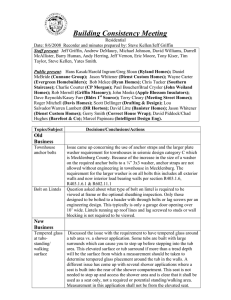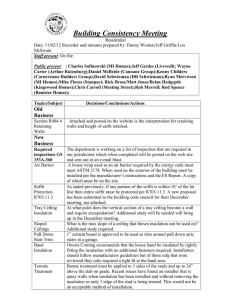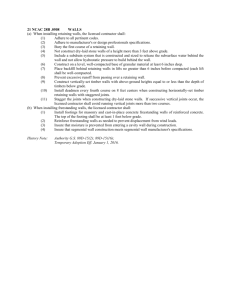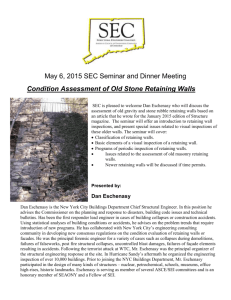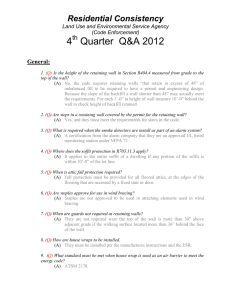Building Consistency Meeting
advertisement
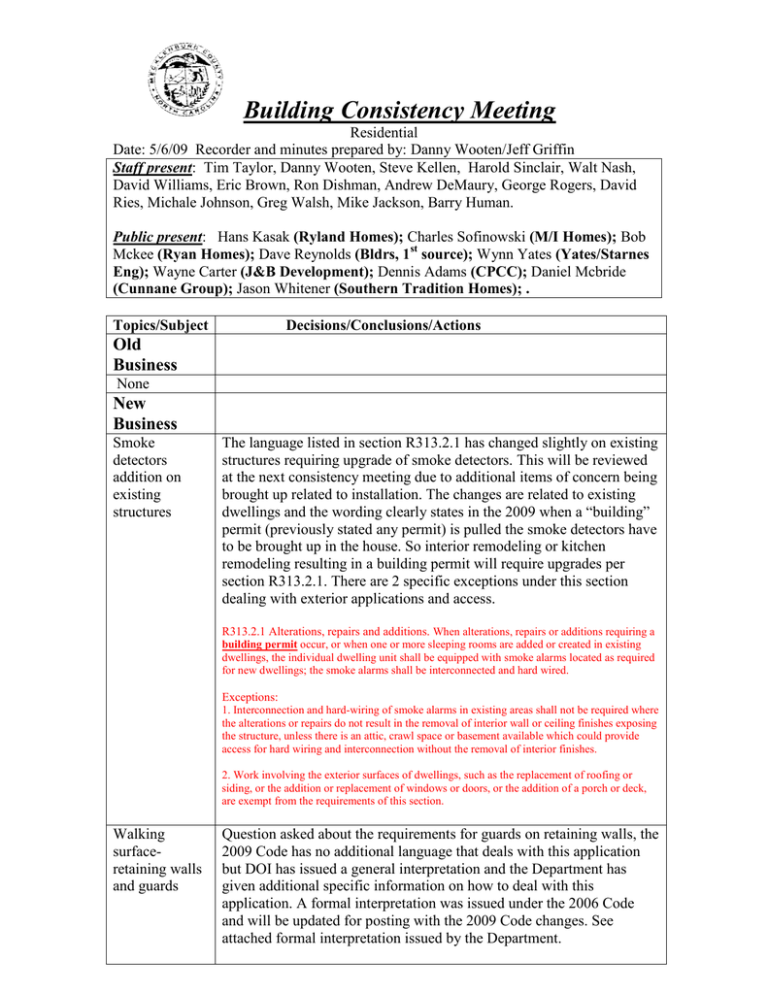
Building Consistency Meeting Residential Date: 5/6/09 Recorder and minutes prepared by: Danny Wooten/Jeff Griffin Staff present: Tim Taylor, Danny Wooten, Steve Kellen, Harold Sinclair, Walt Nash, David Williams, Eric Brown, Ron Dishman, Andrew DeMaury, George Rogers, David Ries, Michale Johnson, Greg Walsh, Mike Jackson, Barry Human. Public present: Hans Kasak (Ryland Homes); Charles Sofinowski (M/I Homes); Bob Mckee (Ryan Homes); Dave Reynolds (Bldrs, 1st source); Wynn Yates (Yates/Starnes Eng); Wayne Carter (J&B Development); Dennis Adams (CPCC); Daniel Mcbride (Cunnane Group); Jason Whitener (Southern Tradition Homes); . Topics/Subject Decisions/Conclusions/Actions Old Business None New Business Smoke detectors addition on existing structures The language listed in section R313.2.1 has changed slightly on existing structures requiring upgrade of smoke detectors. This will be reviewed at the next consistency meeting due to additional items of concern being brought up related to installation. The changes are related to existing dwellings and the wording clearly states in the 2009 when a “building” permit (previously stated any permit) is pulled the smoke detectors have to be brought up in the house. So interior remodeling or kitchen remodeling resulting in a building permit will require upgrades per section R313.2.1. There are 2 specific exceptions under this section dealing with exterior applications and access. R313.2.1 Alterations, repairs and additions. When alterations, repairs or additions requiring a building permit occur, or when one or more sleeping rooms are added or created in existing dwellings, the individual dwelling unit shall be equipped with smoke alarms located as required for new dwellings; the smoke alarms shall be interconnected and hard wired. Exceptions: 1. Interconnection and hard-wiring of smoke alarms in existing areas shall not be required where the alterations or repairs do not result in the removal of interior wall or ceiling finishes exposing the structure, unless there is an attic, crawl space or basement available which could provide access for hard wiring and interconnection without the removal of interior finishes. 2. Work involving the exterior surfaces of dwellings, such as the replacement of roofing or siding, or the addition or replacement of windows or doors, or the addition of a porch or deck, are exempt from the requirements of this section. Walking surfaceretaining walls and guards Question asked about the requirements for guards on retaining walls, the 2009 Code has no additional language that deals with this application but DOI has issued a general interpretation and the Department has given additional specific information on how to deal with this application. A formal interpretation was issued under the 2006 Code and will be updated for posting with the 2009 Code changes. See attached formal interpretation issued by the Department. Plan review cut off Residential Services has established a cut off for plan review submittals under the NC 2006 Code. Plan review will no longer accept plans after 6-12-09 under the current version of the code, all plans after this date should reflect the 2009 code changes. Code enforcement re-organization Information was discussed concerning the Departments efforts to reorganize and change some of the current processes to include field inspection operations. Several areas are being identified for further study to include the possibility of multi-trade inspectors on residential sites. Information and BDC contacts were mentioned for Builder input on these initiatives. There will be a public meeting and updates on these efforts will also be discussed at the Charlotte HBA and future consistency meetings. Your input is valuable in deciding the outcome of how services will be provided in the future. Brick veneer on supported on triple rafters Question asked about attached detail on brick veneer support on triple rafters and how this is to be attached. Under the NC language dealing with this section the illustration is not correct and an alternate was proposed that did not make it print. We will check with the State to see if an errata can be issued related to the Figure above. To address the questions, in NC there is no requirement in this text to fasten the lintel to adjacent wall studs, full support is from the triple rafters (trusses must be designed for that additional load). In addition the longer leg of the lintel is laid flat (horizontal) instead of the typical vertical installation, picture doesn’t match text related to that installation as well. No specific nailing in given in this detail but the fastening schedule Table R602.3(1) has a “built up girder and beams, 2inch lumber layers using 10d nails. Nailing each layer as follows: 32”o.c.at top and bottom and staggered, Two nails at ends and at each splice”. Column attachment top and bottom Issue came up about having to secure columns at the top and bottom, no fastening schedule is given for these attachments but per Section R407.3 which has changed slightly it does require restraint: R407.3 Structural requirements. The columns shall be restrained to prevent lateral displacement at the top and bottom ends. Wood columns shall not be less in nominal size than 4 inches by 4 inches (102 mm by 102 mm) and steel columns shall not be less than 3inch-diameter (76 mm) standard pipe or approved equivalent. Anchors at basement wall Question asked about anchors on basement walls per section R404.1. This is a new requirement for these walls and addresses an increase bolting requirement, band attachment, lateral restraint at bottom end and an unbalance load across the depth of the home along with an aspect ratio table. This section of the code has additional implications related to crawl space walls and will be discussed in detail at next consistency meeting. For basement walls with more than 48” of unbalanced fill they will need to have anchors at 36”o.c. spacing. CODE INTERPRETATION MECKLENBURG COUNTY CODE: 2006 NC RESIDENTIAL CODE SUBJECT: RETAINING WALL GUARDS Building Code Enforcement REVIEWED: RESIDENTIAL CONSISTENCY TEAM Question: Are guards required on retaining walls that have more than a 30” drop off to a lower grade level? Code reference: Section R312.1 Answer: Yes, if part of an egress path or along other dedicated walking surface DOI interpretation: “The 2006 NC Residential Code, Section R101.2 states; “Accessory structures are not required to meet the provisions of this code except decks, gazebos and retaining walls as required by Section R404.1.3.” The NC commentary for this code section states; “All decks and gazebos require permits along with retaining walls per section R404.1.3.” In accordance with the above, and R404.1.3, it is my opinion that the following residential retaining walls require design and are therefore required to be permitted: 1. All retaining walls with an unbalanced condition exceeding 48 inches 2. All retaining walls that cross over property lines 3. All retaining walls that support buildings and their accessory structures The NC Residential Code, Section R312.1 states; “Porches, balconies, or raised floor surfaces located more than 30 inches (762 mm) above the floor or grade below shall have guards ...... in height.” The NC commentary for this section states: “The guard provisions of this code address the issue of providing protection for occupants from falling off of any elevated walking surface.” It is my opinion that guards (complying with R312) must be included on any of the above mentioned retaining walls when the finished area on the high side of the wall is more than 30 inches above the grade below and part of an egress route or other dedicated walking surface”. In addition if the egress route or dedicated walking surface (not grass, but could include-concrete, gravel, pavers, wood walkways, etc…) is within 36”of a retaining wall meeting the requirements as listed above, a guard will be required. To not be considered adjacent to a retaining wall there needs to be at least 36” or greater level grade separation between the retaining wall and walking surface as illustrated below and can be made up of grass area or mulch bed with plantings. A steep grade associated with the walking surface where someone stepping off and cannot regain their balance will require a guard regardless of separation distance. (no guard required) Approved By ___Gene Morton_______ F:\CORE\CORESUP\KATHY\GENE\CDEINTRP\wythe.doc (Guard required) Date _______8/18/08_______________
